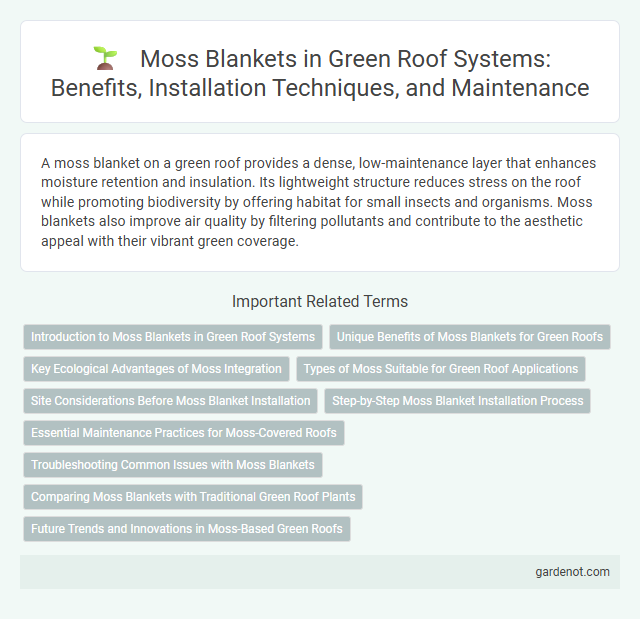A moss blanket on a green roof provides a dense, low-maintenance layer that enhances moisture retention and insulation. Its lightweight structure reduces stress on the roof while promoting biodiversity by offering habitat for small insects and organisms. Moss blankets also improve air quality by filtering pollutants and contribute to the aesthetic appeal with their vibrant green coverage.
Introduction to Moss Blankets in Green Roof Systems
Moss blankets in green roof systems provide a lightweight, low-maintenance layer that enhances moisture retention and biodiversity. Their dense, water-absorbent structure improves insulation and reduces stormwater runoff, making them ideal for urban environments. Moss blankets support the establishment of resilient plant communities by stabilizing substrates and promoting microhabitat diversity.
Unique Benefits of Moss Blankets for Green Roofs
Moss blankets provide exceptional water retention and natural insulation, reducing stormwater runoff and enhancing urban heat island mitigation. Their lightweight structure minimizes load on green roof systems, allowing for easier installation on various building types. Moss blankets also support biodiversity by creating microhabitats for insects and small organisms, contributing to urban ecological balance.
Key Ecological Advantages of Moss Integration
Moss blankets on green roofs enhance biodiversity by providing microhabitats for insects and microorganisms, contributing to urban ecosystem health. Their high water retention capacity reduces stormwater runoff and mitigates flooding risks while promoting natural insulation and energy efficiency. Moss integration supports air quality improvement through pollutant absorption and carbon sequestration, reinforcing sustainable urban environmental management.
Types of Moss Suitable for Green Roof Applications
Types of moss suitable for green roof applications include cushion moss (Leucobryum glaucum), sheet moss (Hypnum cupressiforme), and rock cap moss (Dicranum scoparium), each offering excellent water retention and erosion control. These moss varieties thrive in shallow substrates and low-nutrient environments, making them ideal for green roofs with minimal maintenance requirements. Selecting native moss species enhances biodiversity and ensures better adaptation to local climate conditions on green roofs.
Site Considerations Before Moss Blanket Installation
Evaluating the site for moisture levels, shade, and exposure is critical before installing a moss blanket on a green roof to ensure optimal growth and longevity. Soil pH and substrate composition must be compatible with moss species requirements, while surface texture should promote adhesion and prevent erosion. Proper assessment of wind exposure and drainage patterns minimizes desiccation risk, supporting a healthy, sustainable moss blanket coverage.
Step-by-Step Moss Blanket Installation Process
Start by preparing the roof surface, ensuring it is clean, smooth, and waterproofed to prevent moisture damage. Lay down a moisture-retentive substrate, such as a blend of peat moss and compost, to promote moss growth. Gently press pre-grown moss mats or flakes onto the substrate, then lightly water them to establish root contact and encourage rapid colonization.
Essential Maintenance Practices for Moss-Covered Roofs
Moss blankets on green roofs require consistent moisture monitoring to prevent desiccation and maintain optimal hydration levels, essential for moss vitality and growth. Periodic removal of debris such as leaves and twigs is necessary to avoid excess weight and inhibit fungal growth, which can damage the moss layer. Ensuring adequate air circulation and inspecting for pests or diseases regularly supports the overall health and longevity of moss-covered roofs.
Troubleshooting Common Issues with Moss Blankets
Moss blankets often face issues such as poor establishment due to insufficient moisture retention, pest infestations like slugs or insects, and growth inhibited by excessive sunlight or pollution. Effective troubleshooting requires regular irrigation to maintain optimal hydration levels, application of organic pest control methods, and strategic placement to ensure adequate shade and air quality. Monitoring soil pH and nutrient balance further supports healthy moss blanket development on green roofs.
Comparing Moss Blankets with Traditional Green Roof Plants
Moss blankets offer a lightweight and low-maintenance alternative to traditional green roof plants such as sedums and grasses, thriving in shaded and damp environments where other species may struggle. Their dense, spongy structure enhances water retention and provides superior insulation, reducing thermal fluctuations more effectively than typical green roof vegetation. Moss blankets also require less soil depth, lowering structural load demands and installation costs while promoting biodiversity on urban rooftops.
Future Trends and Innovations in Moss-Based Green Roofs
Moss blankets are emerging as a sustainable innovation in green roofing, offering enhanced water retention and air purification benefits compared to traditional vegetation. Advances in biomimetic design and genetic engineering are enabling the development of moss species with improved drought tolerance and growth rates, making them ideal for urban environments facing climate change challenges. Integration of smart irrigation systems and sensor technology is set to optimize moss blanket health, reducing maintenance costs and increasing the longevity of green roof installations.
Moss blanket Infographic

 gardenot.com
gardenot.com